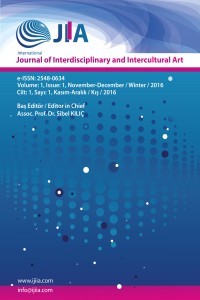KAMUSAL SANAT ETKİNLİKLERİNİN KAMUSAL ALAN KULLANIM DEĞERİ ÜZERİNDEKİ ETKİLERİ
Kamusal Alan, Kamusal Alan Kullanım Değeri, Kamusal Alan Aktiviteleri, Kamusal Sanat Etkinlikleri, Kentsel Mekân Kalitesi
THE EFFECTS OF PUBLIC ART ACTIVITIES ON THE VALUE OF PUBLIC SPACE USE
Public Space, Value Of Public Space Use, Public Space Activities, Public Art Activities, Urban Space Quality,
___
- Arendt, H. (2012). İnsanlık Durumu (B. Sina Şener, Çev.). İstanbul: İletişim Yayınları.
- Asımgil, B. (2018). Kentin Toplumla Uzlaşı Zemini, Marjinal Sokak Sanatı. Yapı. 439. 48–53.
- Atakan N. (1998). Arayışlar: Resim ve Heykelde Alternatif Akımlar, (Z. Rona, Çev.). İstanbul: Yapı Kredi Yayınları.
- Benn, S.I. & Gaus, G.F. (1983). Public and Private in Social Life. London: Croom Helm.
- Bilge Uysal, F. (2021). Kamusal Alanların Evrilmesi. Mimarlık ve Yaşam. 6(1).141-156.
- Bolat Aydoğan, K. (2009). Sanatta Disiplinlerarası Bir Yaklaşım: Performans Sanatı. Art-e Sanat Dergisi.1 (1).1-17.
- Ercan, M. A. (2013). Kamusal Sanatın ‘Kamusallığı’: Erişim, Aktör, Fayda Yaklaşımı. İdealkent. 10(2013), 220-255. ISSN: 1307-9905
- Foucault, M. (2004). Sécurité, territoire, population: cours au Collège de France. Paris: Gallimard Seuil.
- Gehl, J. (1987). Life Between Buildings: Using Public Space. Copenhagen: Arkitektens Forlag.
- Gehl, J. (2011). Life Between Buildings: Using Public Space. Washington: Island Press.
- Guinarda, P. & Margierb, A. (2018). Art as a new urban norm: Between normalization of the City through art and normalization of art through the City in Montreal and Johannesburg. Cities. 77 (2018).13–20. http://dx.doi.org/10.1016/j.cities.2017.04.018
- Gürcan A. G. (2003). Çağdaş Türk Sanatında Performans. Yüksek Lisans Tezi. Hacettepe Üniversitesi Sosyal Bilimler Enstitüsü.
- Habermas, J. (2003). Kamusallığın Yapısal Dönüşümü (T. Bora ve M. Mithat, Çev.). İstanbul: İletişim Yayınları.
- Hall, T. & Robertson, I. (2001). Public Art and Urban Regeneration: advocacy, claims and critical debates. Landscape Research. 26(1). 5–26. DOI: 10.1080/01426390120024457
- Hall, T. (2003). Art and urban change. Public art in urban regeneration. In: A. Blunt, P. Gruffudd, J. May, M. Osborn, D. Pinder (Eds.). Cultural Geography in Practice. London: Arnold.
- Jasmia, M.F., Hanita, N. & Mohamad, N. (2016). Roles of Public Art in Malaysian Urban Landscape towards Improving Quality of Life: Between aesthetic and functional value. Procedia - Social and Behavioral Sciences. 222.872 – 880. https://doi.org/10.1016/j.sbspro.2016.05.201
- Kabaş, B. (2019). Sokaktaki Müzik: Kapı Önünde Mayalanan Bir Halk Gösterisi. Galatasaray Üniversitesi İletişim Dergisi, 4. 94–106. DOI: 10.16878/gsuilet.555210.
- Kalcic, S. (2012). Architecture and New Media Art/Media Façades, Video and Light-Intallations. Online Journal of Art and Design. 1( 3). 1-15.
- Kluszczynski, R. (2010). Strategies of Interactive Art. Journal of Aesthetics & Culture. 2(1). 5525. DOI: 10.3402/jac.v2i0.5525
- Lynch, K. (1984). Good city form. Cambridge:MIT Press.
- McCarthy, J. (2006). Regeneration of Cultural Quarters: Public Art for Place Image or Place Identity?. Journal of Urban Design. 11(2). 243–262. DOI: 10.1080/13574800600644118
- Miles, M. (1997). Art, Space and the City: Public Art and Urban Futures. New York: Routledge.
- Norberg Schulz, C. (1980). Genius Loci: Towards a Phenomenology of Architecture. New York: Rizzoli.
- Parlakkalay, H. (2020). Kamusal Alanda Sanat ve Sanat Eserleri. Afyon Kocatepe Üniversitesi Sosyal Bilimler Dergisi. 22( 4). 1157–1172. DOI: 10.32709/akusosbil.803027
- Public Art Consultancy Team (2005). The Cardiff Public Art Strategy. Retrieved July, 17, 2021 fromhttps://www.cardiff.gov.uk/ENG/resident/Planning/Documents/The%20Cardiff%20Public %20Art%20Strategy.pdf
- Roberts, M. (1998). Art in Public Realm. In C. Greed & M. Roberts (Eds.), Introducing Urban Design (pp. 116-129). London: Addison Wesley Longman Ltd.
- Sennett, R. (1996). Kamusal İnsanın Çöküşü (S.Durak ve A. Yılmaz, Çev.) İstanbul: Ayrıntı Yayınları.
- Susuz, M. ve Eliri, İ. (2017). Kamusal Alanda Sanat Olgusu ve Görsel Kültür. Journal of Turkish Studies.12(13). 531-546. http://dx.doi.org/10.7827/TurkishStudies.11923
- Uluçay, N. Ö. (2019). Mekânın Ögesi Olarak Çağdaş Sanat. Sosyal Bilimler Dergisi. 6(38).132-138. http://dx.doi.org/10.16990/SOBIDER.5015
- Uzgören, G. ve Erdönmez M. E. (2017). Kamusal Açık Alanlarda Mekân Kalitesi ve Kentsel Mekân Aktiviteleri İlişkisi Üzerine Karşılaştırmalı Bir İnceleme. Megaron. 12(1).41-56. DOI: 10.5505/megaron.2016.42650
- Whyte, W.H. (2000). The Social Life of Small Urban Spaces. In A. M. Orum, Z. P. Neal, (Eds.), Common Ground? Readings and Reflections on Public Space (pp. 32-39). New York: Routledge.
- Worth, M. (2003). Public art, public space, urban design - Case studies creating significance through public places art an inclusive + interdisciplinary practice. Public Art & Urban Design Interdisciplinary and Social Perspectives. 4(2003). 47-59.
- Yavuz, A., Acar, H. & Ataoğlu, N., C. (2020). Urban Readings on Public Art Representations in Landscape Architecture. ICCAUA-2020: 3rd International Conference on Contemporary Affairs in Architecture and Urbanism. 369-380. DOI: 10.38027/N372020ICCAUA3163634
- Yıldız, D. (2006). Binalarla Tanımlı Dış Mekânların Kullanım Değeri Analiz Modeli. İtüdergisi/a. 5(1). 115-127. DOI: 10.5505/megaron.2016.42650
- Zabawa Krzypkowska, J. & Gron, K. (2020). Art in the public space, different aspects of artistic, activities in architecture. WMCAUS 2020.IOP Conference Series: Materials Science and Engineering. 960. 032090. DOI:10.1088/1757-899X/960/3/032090
- Zebracki, M., Vaart, R. & Aalst, I. (2010). Deconstructing public artopia: Situating public-art claims within practice. Geoforum. 41.786–795. https://doi.org/10.1016/j.geoforum.2010.04.011
- Zebracki, M. (2011). Does cultural policy matter in public-art production? The Netherlands and Flanders compared, 1945-present. Environment and Planning A. 43(12):2953-2970. https://doi.org/10.1068/a44215
- Başlangıç: 2016
- Yayıncı: Sibel KILIÇ
ANADOLU KÜLTÜRÜ ve SEMBOLLERİNİN GÜNÜMÜZ TEKSTİL SANATINA/TASARIMINA YANSIMALARI
FİZİKSEL ENGELLİ KULLANICILARIN İÇ MEKÂN DONATI ELEMANLARINA YÖNELİK TERCİHLERİNİN BELİRLENMESİ
Kemal YILDIRIM, Menşure Kübra MÜEZZİNOĞLU, Süleyman TÜRKDAL
BİR METAMODERNİST UYGULAMA OLARAK PERFORMATİST FOTOĞRAF VE ÖZNENİN DÖNÜŞÜ
TÜRKİYE’DEKİ VİYOLA İCRACILARININ MÜZİK PERFORMANS ANKSİYETESİ (MPA) ÜZERİNE BİR İNCELEME
Nilüfer ATILGAN AVCI, Turan SAĞER
SANAT VE BİLİM BAĞLAMINDA İLKER YARDIMCI’NIN HEYKELLERİNE DÜŞÜNSEL YAKLAŞIMLAR
E. Yıldız DOYRAN, Burhan YILMAZ
KAMUSAL SANAT ETKİNLİKLERİNİN KAMUSAL ALAN KULLANIM DEĞERİ ÜZERİNDEKİ ETKİLERİ
TEKNİK VE KAVRAM BAĞLAMINDA ÇAĞDAŞ BİR BASKIRESİM SANATÇISI: ENDI POSKOVIC
DEBUSSY’NİN MADAME VASNİER MELODİLERİ ÜZERİNE BİR ANALİZ
Betül YARAR KOÇER, Çiğdem ALADAĞ
DRAMA FİLM MEKANLARINDA KULLANILAN DONATILARIN SEÇİLMİŞ FİLMLER ÜZERİNDEN TARİHİ SÜRECİNİN OKUNMASI
